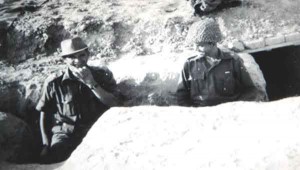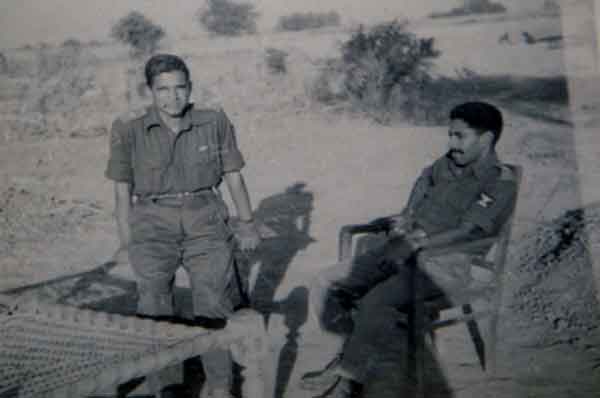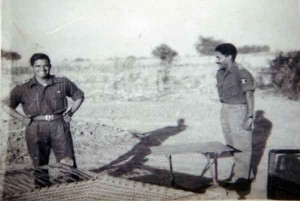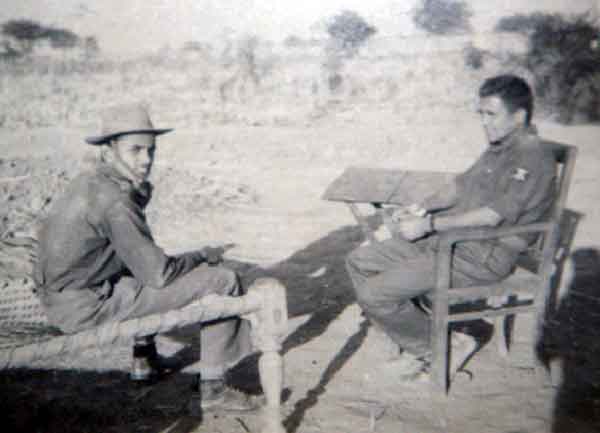The incidents narrated ahead are based on the experience of 2nd Lieutenant Baljit Singh, 3rd Madras Infantry Battalion, 69th Infantry Brigade, who had participated in the legendary 1965 Indo-Pak war. The contents are a pen picture of the Indian counter offensive in the Pakistani Punjab sector, which includes ‘Attack on Maharjke’, ‘Battle of Phillora’ and ‘Siege on Sialkot’.
It was somewhere in the second week of April 1965 when 69th infantry brigade, in which I was attached, received the news of Pakistani misadventure in the Kutch sector of Gujarat state. The senior officials of the brigade were caught with the trauma of an all out war with Pakistan.
Every chap was excited and was bubbling with energy as well as fuming with some amount of anger, over such treacherous act done by Pakistanis.
In the upcoming days that followed their fear become a reality, when the whole of the mountain division force was put on an alert. I was undergoing the ‘Weapon Course’ at Mhow, Madhya Pradesh, when a short notice was received by me to join back with my battalion, which was at Dharchula, Uttaranchal, close to Indo-China border.
After the war with China in 1962 a one lakh force was raised under the banner of ‘Mountain Divisions’, which totaled ten in number. This force mostly consisted of the officers recruited on a large scale from the ‘Officers Training Centers’(OTC), established all over the country after the Chinese invasion, since during those days there happened to be an acute shortage of officers.
Within a few days I reported at my battalion headquarters of 3rd Madras, which along with 9th Kumon and 6th J&K Rifles constituted the 69th infantry brigade. Dharchula is a valley surrounded by peaks ranging from 10000 to 14000 feet. The route towards Dharchula had to be traversed through Bariely, Pilibhit and Pithoragarh. The medium of transportation were mini-buses, since the route was only jeepable at that time. There was rail route available but only till Tanakpur which was the ‘rail head’.
Upon my arrival it was learnt that the brigade was on a notice of 4 hours for its move. Every chap was excited and was bubbling with energy as well as fuming with some amount of anger, over such treacherous act done by Pakistanis. Most of us were consoling ourselves that when we were ready for a fight with China, the Chinese did not show up but now we will surely not leave the Pakistanis without having faced our wrath.
…as it is said no one can predict future, the moment we reached Pathankot and our respective battalion and company commanders had started to work on the strategy for countering Pakistani threat in Punjab sector, the news of ceasefire arrived, which was sponsored by the then superpowers.
In the wake of another Chinese misadventure the mountain divisions used to hold different exercises for getting aware of the topography and acclimatizing with the high altitude conditions, on the Indo-China border. Our brigade used to hold an annual exercise in which we had to march our way through 300 kilometers from Dharchula to Haldwani. Such an exercise used to happen in the ascending hierarchy, that is to say first a section level exercise used to take place, then a platoon size, then a company size and finally the battalion size drill was performed. The amount of struggle faced by us while trekking the area during patrolling or when such exercises were carried out helped in making most of us a true fighting machine.
Mobilization & Deployment
When the final movement order was received the brigade started to move out of Dharchula towards the new brigade headquarters at Pathankot, in Punjab. Since there were not many military transport vehicles available so most of the mobility was made possible by hiring civilian trucks and buses. The path which we took to reach Pathankot in the shortest time possible was through Pithoragarh, Tanakpur, Katgodam, Bariely, Muradabad, Meerut, Saharanpur and Ambala. It took us seven days to reach our destination but everyone was quite happy to see the kind of civilian support that we received on our way. All the people gathered at every stoppage we took, for handing over eatables. Many civilians upon watching us used to start shouting motivational slogans like ‘Victory to Mother India’, ‘Jai Hind’ and what not.
Such an atmosphere made us determined about the task which we had to perform. But as it is said no one can predict future, the moment we reached Pathankot and our respective battalion and company commanders had started to work on the strategy for countering Pakistani threat in Punjab sector, the news of ceasefire arrived, which was sponsored by the then superpowers. Few of us were relieved of the mental tension developed before a fight but still there were many who were disappointed for not being able to see action and take revenge of the breach of faith that Pakistan had done.
In the mean time when ceasefire was officially declared, we were able to make up for the lost time. Not only that but we were also provided training on tanks because in case of emergency one has to go even beyond his call of duty. I along with few other officers was explained in detail many aspects of an armored vehicle and we were given an idea about the fire control system of a tank. The tanks on which we were trained consisted mostly of world war-2 tanks like the ‘Sherman’ and ‘Stuart ‘light tanks.
Staying for about a month at Pathankot the brigade was finally moved back to Dharchula. Few of the officers even went on a short leave straight from Pathankot, when the order to pull back was received.
Re-mobilization
After we fell back to Dharchula from Pathankot and assumed our duties, the whole of July and first week of August had passed away. Many of us continued to think over and over about the skirmish which had taken place with Pakistan. There were a few who thought that it was better to sought out matters with Pakistan for once and for all rather than getting involved in the proxy war game that Pakistan was playing with us.
May be the almighty listened to our anguish and had blessed us when in the last week of August, we received a message regarding the re-mobilization of the entire brigade once again towards Punjab, to counter the threat of growing Pakistani infiltration near ‘Akhnoor’. It appeared as if we were being refueled by the enthusiasm to fight, after hearing the news.
…the need of better transport became a hurdle since there were hardly any heavy transport vehicles available during those days. But somehow we were able to reach Ambala as per schedule.
Within couple of hours it was officially declared by our senior officers about the re-mobilization. The same events happened once again but this time instead of Pathankot the new destination was ‘Sambha’, in J&K. Since the things were moving much quickly than before, so we made Ambala our junction from where the respective battalions or brigades would move on to take up their positions.
On the way we were being re-grouped at Petrol pumps, in order to avoid any confusion, as the movement of troops was on a larger scale and was carried out much swiftly.
Once again the need of better transport became a hurdle since there were hardly any heavy transport vehicles available during those days. But somehow we were able to reach Ambala as per schedule. The 69th infantry brigade was instructed to establish their administrative and support base at Pathankot, while the three infantry battalions would move close to the international border.
The 3rd Madras battalion was ordered to move towards Sambha and secure it since there were reports of a Pakistani attack on the bridge made on river Chenab at Akhnoor. The moment we reached at Sambha we got the news of Pakistani Air raid on Pathankot in which the heavy baggage of 69th infantry brigade was lost. Listening to this every single person of the battalion was enraged because that baggage which got destroyed in the raid also contained the personal belonging of the soldiers.
 For next two days our respective company commanders along with the battalion commanders held on briefings after briefings about the strategy to carry out the counter attack in Pakistani Punjab sector. I along with other officers was taken at the forward posts to recce the international border, so that at the time of assault nothing goes wrong.
For next two days our respective company commanders along with the battalion commanders held on briefings after briefings about the strategy to carry out the counter attack in Pakistani Punjab sector. I along with other officers was taken at the forward posts to recce the international border, so that at the time of assault nothing goes wrong.
Continued…: 1965 War: True Story of 2/Lt Baljit Singh- II
By presenting articles, through www.indiandefencereview.com, related to the operations carried out by the Indian Army, on the western front during 1965 war, I intend not to question anybody’s contribution who had participated in that war. But I wish to tell to our upcoming generations about the significance of this war, which was termed as the “War of Young Officers” as well as ‘The bloodiest war fought by the Indian army ever’, not only owing to the high number of casualties inflicted on the part of the enemy but due to the quality of leadership shown by young recruits irrespective of the kind of commission which was offered to them. – Colonel Baljit Singh.








Madarchod ,jhotay, haray way Indians
It was very nice and encouraging to go through the article.
so encouraging…
Please explain, what do you intend to say?
Very interesting narration. I salute this hero of our India Army…who is also my Hero.
I don’ t understand what do you mean katia! I am pretty sure that you were not in existence when Indian army’s officers, like the author of this article where spilling their sweat and blood to safe guard the hard earned independence. How can you question the credibility of the organisation because of which you are enjoying democratic atmosphere. I wish you have tried something of the kind in China or Pakistan and then you would have learnt a good lesson! I strongly condenm your point of view.!
Interesting & very well compiled avoiding military jargons:) I am waiting for the next part(s).